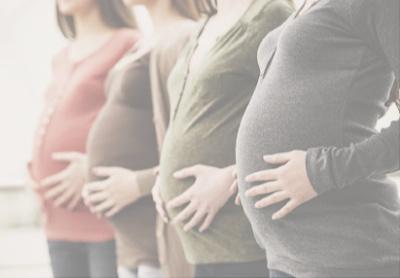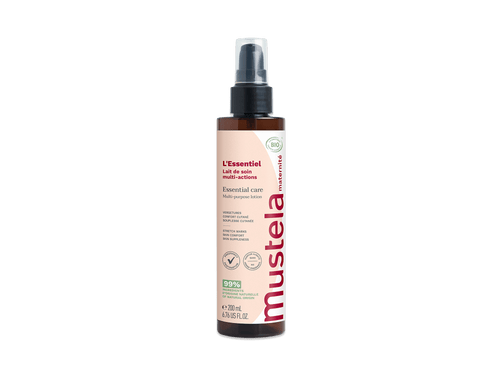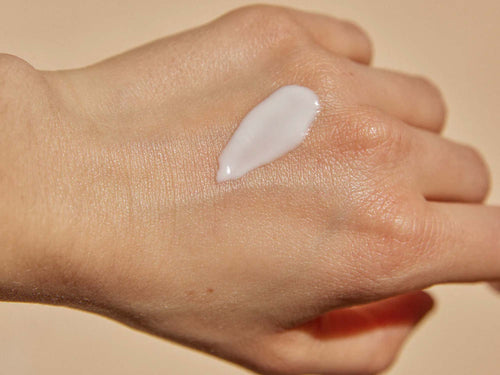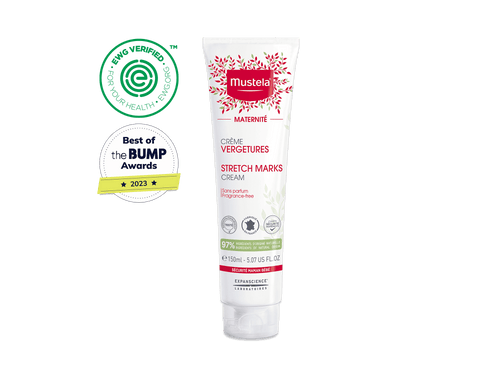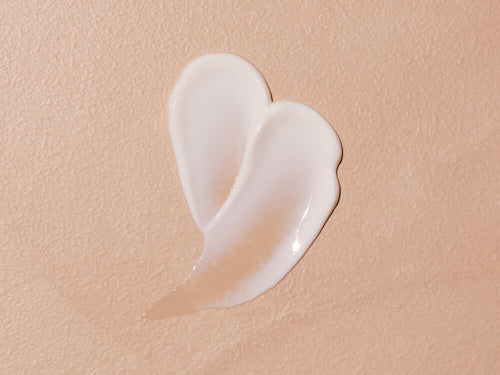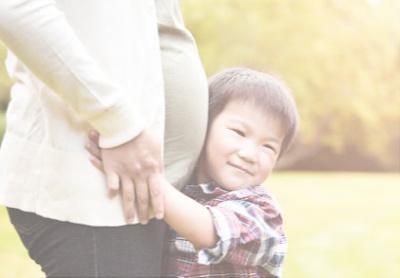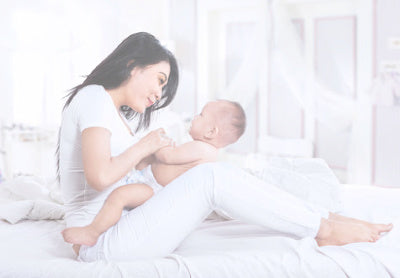Congratulations on your pregnancy! Your baby is growing, and soon you’ll see your pregnant belly growing too.
From a little baby bump to a basketball, all pregnant bellies come in different shapes and sizes. Don’t get caught comparing bellies! Every woman is shaped differently, so pregnant bellies will look different across the board.
But even so, how do you know if your belly is too big or too small and what it can mean? In this article, Mustela’s baby experts will show you what you can expect throughout the different stages of pregnancy.
Table Of Contents
- Will I Start To Show?
- Pregnant Belly: First Trimester
- Pregnant Belly: Second Trimester
- Pregnant Belly: Third Trimester
- Post-Pregnancy Belly
- A Beautiful Pregnancy Starts With Healthy Skin
When Will I Start To Show?

You shared your exciting news with family and friends, and now you're just waiting for your belly to make the announcement to the rest of the world!
The size of your pregnant belly and when it appears depends more on you than it does on the size of your baby. These factors play a role in your growing belly:
- Body shape
- Bone structure
- Muscle tone
- Number of previous pregnancies
- Height
- Weight
We hope that, after looking at some of the factors above, it’s clear that each pregnant belly is unique, and it’s best not to compare yours with your friends’, colleagues’, or even sisters’.
Once your belly does start showing, the shape it takes on might not be what you see in the movies or online.
For example, a woman who carries more weight around her waist may not have a bump that’s very defined early on because the fat tissue around the area may prevent you from seeing a protrusion until much later in the pregnancy.
On the other hand, a woman with less body fat may show much earlier.
Another key factor that affects when you start showing is whether or not this is your first pregnancy. Women who have been pregnant before tend to develop a bump a few weeks earlier than first-time moms. They may also have bigger bumps.
The reason for this is simple: If you’ve been down this pregnancy road before, then your stomach muscles tend to not be as tight as they were the first time, so they’ll naturally stretch out a little faster.
Keep these pre-pregnancy factors in mind when you’re carrying your baby, and don’t judge a baby by its cover! Just because you’re not as big or small as other pregnant moms doesn’t necessarily mean your baby isn’t growing at the right speed.
Another thing to remember is that if you’re carrying multiples, you will most likely start to show sooner and your belly will expand bigger and faster than a woman who’s carrying one baby.
(Note: If you do have concerns about your size, don’t hesitate to talk to your doctor. It’s better to be overcautious than to dismiss a potential problem.)
Pregnant Belly: First Trimester (Weeks 1 to 12)

You may not notice much of a change in the size and shape of your belly, but you’ll sure feel like you’re pregnant even if you’re not showing yet!
Even though your belly isn’t stretching out quite yet, it’s the prime time to begin using Mustela’s Stretch Marks Cream. It’s never too early to start hydrating your skin to help minimize the appearance of stretch marks.
Size And Shape
For some women, their belly doesn’t change much during the first trimester. Your belly may look a little rounder, but that’s most likely due to bloating more than it is a growing baby.
However, by the end of the first trimester, you and your significant other may be the first ones to notice a little bump!
While you may not see much difference on the outside, plenty is going on inside your body, specifically, your uterus. The average woman’s pre-pregnancy uterus is around the size of an orange. By the end of the first trimester, it will have grown to the size of a grapefruit.
What To Expect
Expect your clothes to feel a little tighter by the end of this trimester. Your clothes become snug during this time because your uterus is now the size of a large grapefruit.
But there’s no need to buy maternity clothes just yet — unless you’re too excited to wait, which we totally understand!
Check-Ups
During your first trimester check-ups, you can expect your doctor to look at the following in regard to your pregnant belly:
- Your weight
- The size of your uterus
Come-And-Go Belly
It’s the strangest thing. One day you look like you’re pregnant and the next day your belly is completely flat. Just as quickly as your belly appears, it disappears.
You might be thinking, “What’s up with that?”. This is due in part to bowel distention (the result of constipation and excess gas: your new companions in the first trimester).
The good news is that many women find relief after the first trimester when their digestive system somewhat levels out and adjusts to their new pregnancy hormones.
Pregnant Belly: Second Trimester (Weeks 12 to 27)

This trimester is when the majority of women feel the most comfortable. The first trimester symptoms usually ease up or disappear at this point, and you’re not so big yet that it’s uncomfortable to move around.
Often, this is the time when you really get to enjoy your pregnancy!
Size And Shape
By the end of your second trimester, your belly will really reveal itself. Your uterus is now the size of a basketball, and it might even look like that’s what you’re carrying in your belly!
There’s an old wives’ tale about the shape of your belly and the gender of your baby. It claims that if your shape resembles a basketball, then you’re having a boy, but if your shape resembles a watermelon, then you’re having a girl.
Realistically, your shape has more to do with your body than it does with your baby’s gender. Of course, family and friends will have fun guessing in the meantime!
What To Expect
Feeling your baby move and pain on the lower sides of your abdomen (better known as round ligament pain) are a couple of symptoms you can expect to experience during your second trimester.
Round ligament pain is the equivalent of growing pains. It happens because the muscles and ligaments supporting your growing uterus are stretching.
Another symptom you can look for during the second trimester is the belly itch. Pregnant bellies can easily become itchy bellies.
This is because as your belly grows, your skin stretches — and at a rapid pace — leaving your skin moisture-deprived. But it doesn’t have to be.
Use Mustela’s Stretch Marks Cream and Stretch Marks Oil to create the perfect day and night skin care regimen to keep your skin moisturized, smooth, and healthy throughout your pregnancy.
(Note: If you develop a rash on your belly, check in with your obstetrician.)
Another interesting second-trimester development is the linea nigra. This is basically a dark vertical line that runs down the center of your belly.
While it might startle you (if this is your first pregnancy), you’ll be glad to know that it’s caused by your changing hormones and is completely harmless.
This interesting belly line will also stick around for a while. But you can expect it to start fading a few months after giving birth.
Doctor’s Visits
During your second-trimester doctor’s appointments, expect your doctor to check the following:
- The gender of your baby (an ultrasound will be performed if one hasn’t already been done)
- Your weight
- The fundal height (distance from your pubic bone to the top of your uterus, measured in centimeters; this measurement often matches the number of weeks you’ve been pregnant)
- The size of your uterus
- The position of your baby
Unwanted Belly Touches
Just like a cute baby, pregnant bellies are hard to resist. Touching a pregnant belly can be an irresistible impulse for some people. So, you can expect a bit of stomach-touching from loved ones — and even strangers — when you start to show.
While some women don’t mind a little belly pat here or there, others find it invasive. If you aren’t comfortable with someone touching your baby bump, don’t hesitate to set boundaries.
Pregnancy Photoshoot

When you’re pregnant, most of your world revolves around the bundle of joy that’s growing inside your belly.
This is also a time when many parents tend to stress out. You have to get that nursery ready or pick a suitable co-sleeper, then there’s diapers, car seats, strollers, baby bottles, and everything else in-between!
With all this prep going on, it can be easy to overlook the fact that you will no longer be sporting your baby belly in just a few weeks. So, why not capture this special moment?
The second trimester is a great time to start thinking about a pregnancy photo shoot. If you have a photographer in mind, be sure to reach out to them as soon as possible. You’ll be surprised at how far out they can be booked.
A photo shoot during this period also makes a lot of sense because you’ve reached a stage (around 20 weeks) when your belly is showing, and you’re probably feeling much better than you did during the first trimester.
Pregnant Belly: Third Trimester (Weeks 28 to 40)

You’re in the home stretch and your belly is probably feeling the effects of it! Grow baby, grow! Your excitement and anticipation are at their peak, along with the size of your belly.
Size And Shape
Your uterus is right under your ribs now. Your weight gain will slow down in the last few weeks of pregnancy leading up to delivery. Your belly skin is stretched to the limit, or so it feels.
During this stage, women find themselves carrying high, low, or wide. And you may not even notice a change in the shape of your belly. It may just look bigger!
What To Expect
You’ll likely experience a lot of changes during the last several weeks of your pregnancy. There’s not much room in your belly anymore, so your baby is pushing against your lungs and bladder.
With the position of your uterus during the third trimester, expect to have some shortness of breath and more bathroom visits (if that’s even possible!).
Many women also experience mild swelling of their ankles and feet because of all the weight gain and extra fluid in their bodies. To reduce some of the swelling, you can:
- Avoid standing for too long
- Remember to stretch often if sitting for longer periods of time
- Put your feet up while sitting
- Drink lots of water
While getting swollen feet is pretty common, paying attention to your body is also essential.
If you notice that the swelling won't go down after following the above tips (or if you notice extreme swelling in your fingers and face as well), then you'll need to call your doctor as this might be a sign of a serious condition called preeclampsia.
Doctor’s Visits
During your third-trimester check-ups, your doctor will look at the following things:
- Your weight
- The fundal height
- The size of your baby
- The position of your baby
- The presentation of your baby
Doctor’s visits during this period will also be much more frequent than before. For a healthy pregnancy, most women see the doctor once a month from weeks 4 - 28, every two weeks from weeks 28 - 36, and every week after that for the final homestretch (weeks 36+).
If you’re pregnant with multiples, older, or have any underlying conditions, then you may need to see your healthcare provider more often than the above, especially during the third trimester.
While it can be challenging, hang in there. Remember that this is all to ensure that your little one is growing as healthy as possible!
Hospital Bag For Mom And Baby

As your due date rapidly approaches, knowing what to pack in your hospital bag and what to leave out can be challenging. For example, how many diapers, wipes, and clothing changes (for you and baby) will you need? What about soap and moisturizer?
The good news is there’s no need to figure it out by yourself. Here’s a rundown of how to prepare a hospital bag for you and your soon-to-arrive bundle of joy.
What Do You Need?
Firstly, you’ll want to pack a few copies of your birth plan. These will be excellent quick references for your labor and delivery nurses and other hospital staff members.
(Keep in mind while a birth plan is great, it’s best to leave room for some flexibility because anything can happen during labor!)
You’ll also need comfortable clothing. This can include PJ sets, loose pants or leggings, lightweight tank tops, and comfy slippers or crocs for your feet.
A pack of adult diapers or pads will also come in handy. Many hospitals will have these, or you can purchase your own if you prefer a specific brand.
Also, if you plan to breastfeed your new baby, a nursing bra can be very helpful because it will allow you to quickly and easily nurse without having to get undressed.
Speaking of breastfeeding, a good quality nipple cream should be a hospital bag staple.
Our Nursing Comfort Balm is enriched with vitamin E to nourish and protect your skin before and after breastfeeding. It’s also made from naturally derived ingredients, and it’s vegan, fragrance-free, and dye-free, making it entirely safe for both you and your little one.
Other essential items to pack for yourself include:
- Toiletries (i.e., toothbrush and toothpaste, hairbrush, deodorant, shampoo, lip balm, etc.)
- Cell phone charger (preferably one with an extra-long cord)
- Water bottles
Items that may not be needed but are nice to have include:
- Bath towels (While you may get these from the hospital, hospital towels tend to be scratchy, thin, and small. So, having your own soft cotton towel can help you feel a little more comfortable during this time.)
- A diffuser (If a specific scent helps calm or put you in a good mood, a diffuser is a great option.)
- Good music can also keep the mood calm and positive, so consider adding a portable speaker and playlist to your bag.
Now that you have what you need, it’s time to pack for your little one.
What Does Your Baby Need?

Firstly, you'll want to pack a "going-home-outfit" for them. When choosing this special outfit, pack a couple of options in different sizes because you won't know how big they'll be until they make their grand entrance. Also, if the weather is chilly, don't forget the hats, socks, and gloves.
While a car seat might not fit in a bag, it's also an essential item to bring along because the hospital won't let you leave without it.
If you've never installed a car seat before, it's best to have it installed and ready before you head to the hospital. Trust us, it might look pretty easy, but figuring out which straps go where and how to position the seat in the car can frustrate the best of us.
In addition, remember to bring a couple of bottles if you're planning to bottle-feed. If you'd like to start your baby on formula, most hospitals will have samples that you can take, but you can always bring along your preferred brand.
Other important items:
- Your pediatrician's contact information
- Towels
- Diapers, diaper cream, and cleansing wipes
- Foam shampoo for newborns, gentle cleansing gel for hair and skin, and body lotion to keep your little one’s skin soft and hydrated
- An empty bag to fit any items you'll get from the hospital
Post-Pregnancy Belly
After the big day, your belly won’t look as full or as big as it did during the third trimester. It will also not look anything like it did before you got pregnant. With all the stretching that your uterus did over the past few months, this is completely normal.
Most women’s uteruses can take anywhere from two to six weeks to shrink back. During this time, you may also experience mild period-like pains.
In addition, your belly may feel soft or squishy, and you might also notice that your abdominal muscles are stretched and weak. Don’t worry! In the coming weeks, they’ll begin to strengthen again.
Being patient and loving toward your body is essential, especially during this transitional period into motherhood. You’ve just given birth, and, of course, this has taken its toll on your body.
To help you start feeling good from the inside, remember to eat a balanced diet and drink plenty of liquids.
A Beautiful Pregnancy Starts With Healthy Skin

The size and shape of your belly aren’t nearly as important as maintaining a healthy weight throughout your pregnancy. Remember, several factors play a role in the size and shape of your belly! But, if you are concerned, contact your doctor with any questions.
While embracing your pregnant belly, don’t forget to take care of it! Apply Mustela’s Stretch Marks Oil when you need something that will quickly absorb into your skin to hydrate and help decrease the appearance of stretch marks.
And that’s just one of our many maternity products that you can choose from! Our skin care line works to decrease the appearance of stretch marks, reduce skin discomfort, and protect against the loss of firmness and elasticity.
You’ll have lasting comfort for nine months and beyond!


